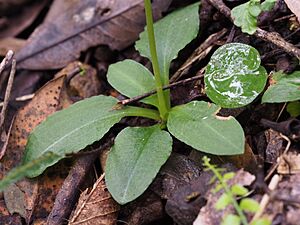Nodding greenhood facts for kids
Quick facts for kids Nodding greenhood |
|
|---|---|
 |
|
| Pterostylis nutans growing in Belgrave South | |
| Scientific classification | |
| Genus: |
Pterostylis
|
| Species: |
nutans
|
The nodding greenhood (Pterostylis nutans) is a special type of orchid. It's also known as the parrot's beak orchid. This plant grows naturally only in eastern Australia. Nodding greenhoods get their name because their flowers "nod" or lean forward. They have a deep notch and a curved, hairy lip (called a labellum).
Contents
What Does the Nodding Greenhood Look Like?
The nodding greenhood orchid has a group of leaves called a rosette. This rosette usually has three to six leaves. Each leaf is shaped like an egg or oval. They are about 15-30 mm (0.6-1.2 inches) long. The leaves are dark green and have wavy edges. They also have a clear stem called a petiole.
A single flower grows on a tall stem. This stem can be 80-300 mm (3-12 inches) high. The flower itself is a see-through white color. It has green stripes and some brown parts. The flower strongly "nods" or leans forward. Each flower is about 18-25 mm (0.7-1 inch) long. It is also 10-14 mm (0.4-0.6 inches) wide.
There is a wide space on each side of the flower. This space is between the petals and the side sepals. The side sepals curve forward. They have a pointed tip and are 10-18 mm (0.4-0.7 inches) long. There is a deep notch between them. The labellum (the orchid's lip) sticks out from the flower. It is 14-18 mm (0.6-0.7 inches) long and about 4 mm (0.2 inches) wide. The labellum is curved, blunt, and has green and brown colors. It is covered with short, stiff hairs. These orchids usually bloom from March to December.
How the Nodding Greenhood Got Its Name
The nodding greenhood was first officially described in 1810. A famous botanist named Robert Brown wrote about it. His description was published in a book called Prodromus Florae Novae Hollandiae et Insulae Van Diemen. The second part of its scientific name, nutans, is a Latin word. It means "nodding" or "drooping," which perfectly describes the flower's shape.
Where Does the Nodding Greenhood Live?
Nodding greenhoods often grow in large groups. They like moist, protected forest areas. You can find them in the Australian states of South Australia, Tasmania, Victoria, New South Wales, and Queensland. They also grow in the Australian Capital Territory.
In Queensland, they grow as far north as the Atherton Tableland. They are found in the eastern half of New South Wales. You can also see them in the southern half of Victoria. They live in the south-eastern part of South Australia. In Tasmania, they are on King and Flinders Islands.
This orchid has also been seen in New Zealand. However, it's thought to be a "vagrant" there. This means it doesn't usually grow there on its own. The special insect that pollinates it isn't found in New Zealand. There is only one group of these orchids left near the Waihaha River in New Zealand. Some records show they were also found in Kaitaia and Castor Bay before.
How the Nodding Greenhood Reproduces
This greenhood orchid is pollinated by a specific type of fungus gnat. The flower's labellum (lip) makes a special scent. This scent attracts the fungus gnat. When the gnat lands on the labellum, it tips the insect into the flower. As the insect tries to get out, it touches the flower's reproductive parts. This action helps the orchid to be pollinated.
Growing Nodding Greenhoods at Home
You can easily grow Pterostylis nutans in pots. They need a sandy soil mix that drains water well. It's important to water the plants regularly when they are growing. When they are not growing (during their dormant period), keep them dry. You should also repot them once a year.


